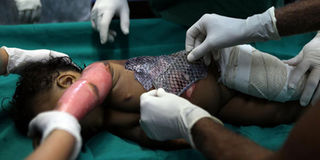Burns, scalds and first aid for victims

The size and depth of the burn will be assessed and the affected area cleaned before a dressing is applied. In severe cases, skin graft surgery may be recommended. STOCK Photo
What you need to know:
- You need to be extra careful when treating burns.
- The longer the burning goes on, the more severe the injury will be, and the longer it may take to heal.
- So you need to cool the burn as soon as possible.
- If someone has a severe burn or scald they are likely to suffer from shock, because of the fluid loss, so they will need urgent hospital treatment.
My neighbour’s daughter recently got a scald. She was playing near a charcoal stove when she accidently hit a saucepan with boiling water. The saucepan tilted to her side and water splashed around her thighs and belly. The maid was away for other errands. But because children have sensitive skin, the damage had already been caused.
Luckily, her father was at home and rushed her to a nearby hospital.
Burns and scalds are common accidents that happen in homes. Dr Ahmed Tinka of Supreme Medical Centre, says burns are caused by dry heat such as a hot iron or fire and car radiators while a scald is caused by something wet such as hot water, steam and hot porridge.
“Most burns and scalds people get come from boiling water, radiators, especially for mechanics, but many times children get burnt by milk or porridge and hot iron boxes. Open fire is common among the epileptics who fall into the fire,” he says, adding: “But usually, there are not many cases of people getting burnt by fire unless it is a case of arson. Acid attacks are also burns but they are different since they are chemical burns.”
Dr Tinka explains that burn wounds are graded according to their severity and impact on the skin. The first degree involves a burn where the skin is not lost but can have blisters. The second degree is when the skin is lost but the inner tissue is not damaged so much.
The third involves the inner degree getting damaged. So, it is about determining the severity.
A parent’s experience
The scars are still visible one year later for Moses Asiimwe, a Primary One pupil at Bokwe Primary School, Pakanyi Sub-county in Masindi District. Asiimwe got burnt while playing near a charcoal stove. His mother Jackline Akugiziibwe, a teacher at the same school, narrates what happened.
“When we returned home, my son started riding a bicycle that had been parked near a charcoal stove. I had not noticed that since I was inside the house. As a young boy, he did not know what would happen next. As I was running errands in the house, I heard a bang. When I came out, my son had tripped and fell in the charcoal stove. His lower body including the thighs and bums were burning. The bicycle was heavier than his body and was directly on top of him as he got burnt,” she explains.
”I rushed and pushed the bicycle off but by the time I got him off the stove, the impact was visible; his thighs had been burnt partially because of the clothes he was wearing. But his bums had been affected most. The skin had been peeled off and had been replaced with the reddish inner skin by the impact of the fire.”
Akugiziibwe says she gave first aid and then rushed him to hospital.
“I felt devastated; I thought my son was going to die. I removed his clothes, placed him on a mat and I tried using cold water to cool the heat, she says adding that her neighbour, who was a nurse, helped her in administering pain killers to reduce the pain.
“But, with such wounds, hygiene is key because I would also change his beddings twice a day.” The nurse also advised her to give him milk which she says helped in reconstructing the affected skin.
Giving first aid
Dr Tinka say the first step is to remove the victim from the area of heat. He says removing jewelry or any clothing that is near the area of burnt skin is important. “However do not remove anything that has stuck to the skin,” he advises.
“Run cold water for at least 20 minutes over the wound to reduce the heat and pain. The water must be clean to avoid infection. Avoid applying creams or butter because these are petroleum products that can prevent heat from escaping and allow the burning to continue deep inside the skin,” he adds.
Dr Tinka adds that mmnor burns usually present blisters. When attending to a burns victim, avoid breaking fluid filled blisters since they protect the skin against infections Avoid a hard spray of water on the affected area as it could lead to more damage especially for third degree burns.”
He says one can administer pain killers first to reduce on the pain of the burn.
Preventive measures
People at risk of getting burnt include epileptics, children under five years and pregnant women. Dr Tinka advises people to protect vulnerable groups from fires to avoid such accidents.
He advises parents to be careful with cooking when children are around and also avoid having hot drinks such as coffee or tea when holding a child.
Dr Emmanuel Nakabago of Kiswa Health Centre says flammable liquids should be kept out reach of children and away from sources of heat and ignition.
“Make sure there are no open fires, keep iron boxes far away from children. Protect children from hot water, milk and porridge. That’s why most modern kitchens are built in such a way that they have worktops to prevent such accidents,” he says.




